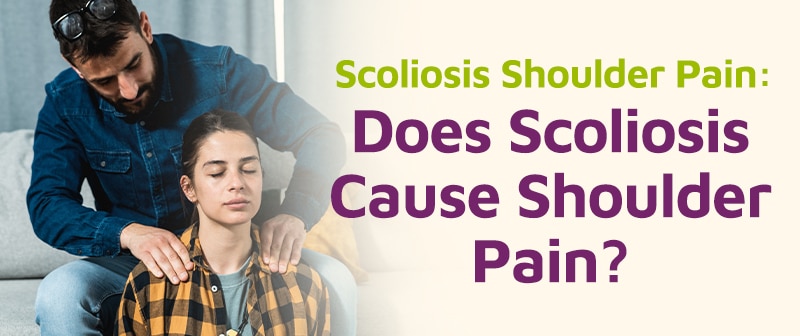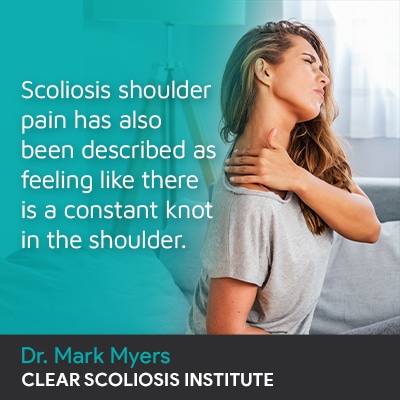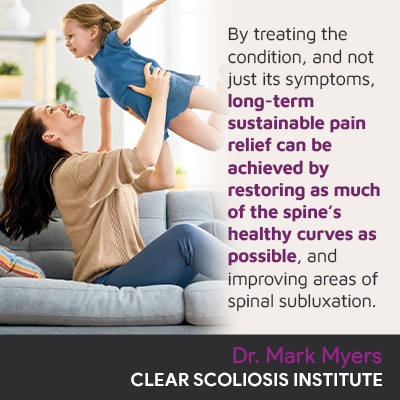
While scoliosis is a structural spinal condition, its effects can be felt throughout the body. One of the main scoliosis symptoms is postural deviation, caused by the condition’s uneven forces disrupting the body’s overall symmetry. Continue reading to find out how scoliosis can cause shoulder pain.
Scoliosis involves the development of an unnatural sideways spinal curve that rotates, introducing uneven forces to the body. Particularly common when scoliosis develops in the upper spine, the effects of those uneven forces can be concentrated in the upper body, causing shoulder pain.
Let’s start our discussion of scoliosis shoulder pain by first exploring key condition features that further classify conditions and guide the design of effective treatment plans.
Part of the diagnostic process involves comprehensive assessment to further classify conditions based on key patient/condition variables; this doesn’t just streamline the treatment process, but also informs the crafting of effective treatment plans.
Part of the reason scoliosis is so often deemed a complex condition to treat is because it’s so highly variable, meaning no two cases are the same, and there is no single treatment plan that can be applied to multiple patients.
Important patient and condition features also help us predict likely symptoms and progressive rates.
As a progressive condition, scoliosis has it in its nature to worsen over time, particularly if left untreated, or not treated proactively, so where a scoliosis is at the time of diagnosis is not indicative of where it will stay.
Important classification points include patient age, curvature location, condition type (cause), and severity.
Patient age is an important factor not only because it indicates a patient’s overall health and responsiveness to treatment, but also because it determines whether or not scoliosis is likely to be painful and progress quickly.
The most-prevalent condition type is adolescent idiopathic scoliosis (AIS), diagnosed between the ages of 10 and 18, but scoliosis also affects adults.
Whether or not scoliosis is likely to be painful depends on a number of factors, the main one being whether or not scoliosis causes compression; scoliosis becomes a compressive condition once skeletal maturity has been reached.
In young patients whose spines are still growing, the spine is experiencing a constant lengthening motion, and that counteracts the compressive force of the unnatural spinal curve, and it’s compression of the spine and its surrounding muscles and nerves that causes the majority of condition-related pain.
So in young patients, we know that pain management is not likely to be a major focus of treatment as the condition has not yet become compressive; however, related muscle pain is still an issue for young patients, and this is due to uneven forces causing uneven wear and muscle imbalance.
While we don’t understand what causes idiopathic scoliosis to develop initially, we do know how to treat it, and we do understand what triggers its progression: growth and development.
So while adults will still experience progression over time, we know that rapid-phase progression is less likely to be an issue, whereas with young patients, monitoring for progression is often a main focus of treatment.
There are three main spinal sections: cervical (neck), thoracic (middle/upper back), and lumbar (lower back).
Scoliosis can develop in any one section, or can be a combined scoliosis, that develops across more than one spinal section (thoracolumbar scoliosis), but most commonly affects the thoracic spine.
Curvature location tells me where to concentrate my treatment efforts, and also indicates likely symptoms; the area of the body closest to the unnatural spinal curve is the most likely to feel its direct effects.
For example, lumbar scoliosis is closely associated with sciatica because as the sciatic nerve starts in the lower back, an unnatural spinal curve in the lumbar spine can expose the spinal nerves in that section to uneven pressure (compression).
So if scoliosis has developed in the upper thoracic and/or cervical spine, this is when shoulder pain is most likely to become an issue.
As mentioned, there are different types of scoliosis a person can develop, and while adolescent idiopathic scoliosis is the most-prevalent form, idiopathic scoliosis is also the most common type to affect adults.
Condition type is determined by causation, and while approximately 80 percent of known diagnosed scoliosis cases are idiopathic, the remaining 20 percent are associated with known causes: neuromuscular scoliosis, congenital scoliosis, degenerative scoliosis, and traumatic scoliosis.
A condition’s underlying cause has to be the focus of treatment, or merely a condition’s symptoms are being treated, but not the condition itself.
Condition severity tells me how far out of alignment a scoliotic spine is, indicates likely symptoms and progressive rates, and informs the crafting of effective treatment plans moving forward.
Condition severity is determined by a measurement known as Cobb angle that’s taken during X-ray; a patient’s Cobb angle is determined by drawing lines from the tops and bottoms of the curve’s most-tilted vertebrae, and the resulting angle is expressed in degrees.
And remember, as a progressive condition, where a scoliosis is at the time of diagnosis is not indicative of where it will stay.
Even mild scoliosis can easily progress to moderate or severe, particularly if left untreated; only proactive treatment can counteract the condition’s progressive nature.
Generally speaking, the higher the Cobb angle, the more severe the condition, and the more likely it is to cause noticeable symptoms like postural deviation and pain:
Mild scoliosis: Cobb angle measurement of between 10 and 25 degrees
Moderate scoliosis: Cobb angle measurement of between 25 and 40 degrees
Severe scoliosis: Cobb angle measurement of 40+ degrees
In the condition’s most-prevalent form, (adolescent idiopathic scoliosis) postural deviation is the main symptom, and uneven shoulders and hips are among the condition’s earliest indicators.
When the body and spine are aligned, meaning straight, the shoulders are front-facing and sit level with each other; however, when a structural issue is present that causes uneven shoulders, as scoliosis can do, one shoulder can sit higher than the other, and/or one shoulder blade can protrude more than the other.
If the shoulders are exposed to uneven pressure and become uneven, neck, shoulder, shoulder blade, and back pain can develop, and the more asymmetric the body is, the more noticeable these imbalances are likely to be.
Levels of scoliosis shoulder pain is related to condition severity and the angle of trunk rotation; the more severe the condition, the more related postural deviation there is likely to be, and the more likely those changes are to cause varying levels of pain and discomfort, particularly in adults for whom the condition is compressive.
So for those experiencing scoliosis shoulder pain, what does it feel like?
Again, each individual will experience the condition in their own way, including scoliosis symptoms, but those who experience scoliosis shoulder pain describe it as a feeling of tightness, soreness, and a pulling sensation in the shoulder and/or shoulder blade that sits higher or protrudes more.
In addition to the condition causing one shoulder to sit higher than the other, and one shoulder blade to protrude more on one side than the other, shoulders can take on an excessively rounded-forward appearance.
Scoliosis shoulder pain has also been described as feeling like there is a constant knot in the shoulder.
Again, shoulder pain caused by scoliosis is also strongly related to curvature location; if a person’s upper back is curved excessively near the top of the spine, this means the muscles that support the upper spine are under strain to counteract the uneven forces of the unnatural curve.
The extra work to provide adequate spinal support strains the muscles of the upper back and can cause aches and pains in the shoulders and shoulder blades.
So for those experiencing scoliosis shoulder pain, what can be done about it?
As mentioned, scoliosis isn’t painful for everyone, but is most likely to cause pain in adult patients who are no longer growing, in cases with a lot of rotation, and/or when severe.
When it comes to scoliosis pain relief, we’re talking about scoliosis treatment options, and there are two main scoliosis treatment approaches to choose between: traditional and conservative .
The traditional approach to scoliosis treatment is not proactive, and can involve a lot of watching and waiting until a patient crosses the surgical-level threshold, when spinal fusion surgery is commonly recommended.
Under a conservative chiropractic-centered treatment approach, proactive treatment started as close to the time of diagnosis as possible is valued, in the interest of preventing progression, increasing condition severity, escalating symptoms, and the need for invasive surgical treatment in the future.
Here at the CLEAR Scoliosis Institute, treatment plans are customized to address key classification points and impact conditions on every level to preserve as much natural spinal function as possible.
There is also an important distinction to be made between treating a condition’s symptoms, and treating the underlying condition itself.
When it comes to addressing scoliosis shoulder pain, as a structural spinal condition, impacting the condition’s underlying structural nature is addressing the root cause of the shoulder pain: the misaligned spine and the condition’s uneven forces.
Only proactive treatment that works towards corrective results, in the form of a curvature reduction, and increasing core strength so the spine is optimally supported by its surrounding muscles, can address the underlying cause of scoliosis shoulder pain: the scoliosis itself.
By treating the condition, and not just its symptoms, long-term sustainable pain relief can be achieved by restoring as much of the spine’s healthy curves as possible, and improving areas of spinal subluxation.
The effects of scoliosis can be felt throughout the body, and not just in the back, so to answer the question, does scoliosis cause shoulder pain, yes, it can.
Scoliosis shoulder pain isn’t a guaranteed part of living with scoliosis, but it can be for some, particularly adults for whom the condition is compressive, in severe forms, and/or when left untreated.
In addition, the nature of scoliosis pain is also affected by the curvature location, so scoliosis that develops in the upper thoracic and/or cervical spine is the most likely to cause related shoulder pain.
Scoliosis shoulder pain is also caused by sore muscles that are strained and tight from struggling to support the spine and compensate for the unnatural spinal curve.
Scoliosis can cause postural changes and range from mild to severe, and uneven shoulders and shoulder blades are one of the condition’s earliest telltale signs.
As a CLEAR-certified scoliosis chiropractor, I address shoulder pain by proactively treating its underlying cause: the scoliosis itself.
Through a chiropractic-centered conservative treatment approach, we can reduce curvatures, restore as much of the spine’s natural curves as possible, improve spinal biomechanics, and reduce the uneven forces causing postural changes, such as uneven shoulders, and related shoulder pain.

CLEAR provides a unique and innovative way of understanding scoliosis. Sign up to receive facts and information you won’t find anywhere else.
